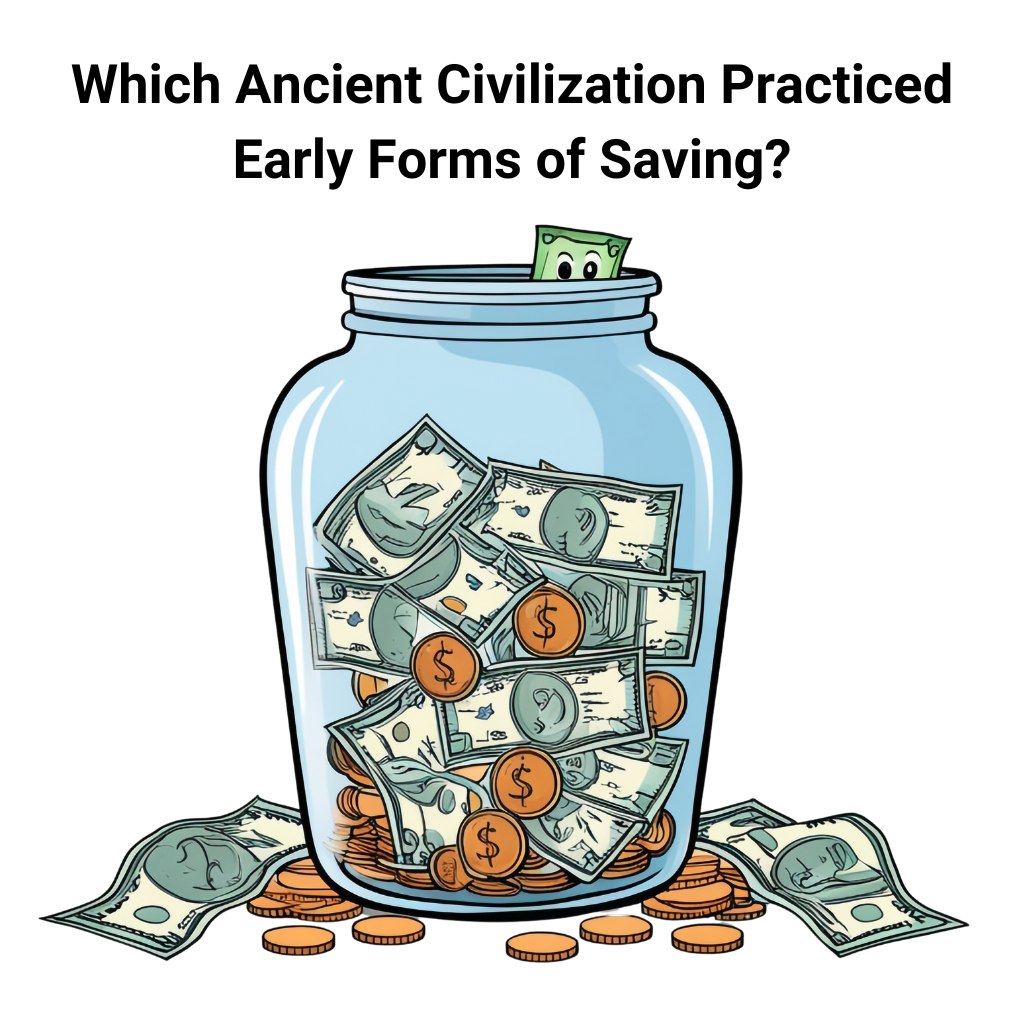Saving, a financial practice we consider modern, actually has its roots deep in ancient history. The concept of saving wasn’t just about setting aside money but involved the preservation of resources, commodities, and wealth for future use.
Which ancient civilization practiced early forms of saving?
It turns out that various ancient cultures devised different methods of saving, laying the groundwork for the banking systems and wealth management strategies we know today.
According to recent data, the U.S. personal saving rate has been steadily declining, dropping from 3.5% in April 2024 to 2.9% in July 2024. This rate reflects the percentage of disposable income that people save after covering taxes and expenses. As the saving rate shrinks, it becomes even more important to understand the roots of saving and how ancient civilizations laid the foundation for modern financial practices.

In this article, we will explore the origins of saving, focusing on how early civilizations like Mesopotamia, Egypt, Rome, and Greece shaped our understanding of financial preservation. By delving into these ancient practices, we can appreciate how they influenced not just individual wealth but also the economic and cultural development of entire societies.
The History of Money and Savings: Early Beginnings
The history of money is closely tied to the evolution of saving practices. Before money was invented, ancient societies relied on bartering goods and services. As these civilizations grew, the limitations of barter systems became evident, leading to currency creation. Once people began using money as a standard measure of value, they also began thinking about how to save it for future needs.
Early savings methods often involved storing grain, cattle, or precious metals like gold and silver. These items had value and could be exchanged in times of need. As societies became more complex, individuals and institutions started developing more formal saving methods, laying the foundation for banking and wealth management systems.
When Was Money Invented?
The concept of money began long before coins or paper currency. The first form of money was bartering, where people exchanged goods or services directly. Around 3,000 BC, in Mesopotamia, clay tablets were used to record transactions, marking an early form of money management. The invention of metal coins around 630 BC in Lydia and China revolutionized trade and provided a tangible way to store value.
History of Bartering
Before coins and paper money existed, bartering was the primary method of trade. This system involved trading goods and services directly. For example, one person might trade livestock in exchange for grain. While bartering allowed for some exchange, it had limitations, such as difficulty finding mutually desirable trades. Eventually, societies needed a standardized medium of exchange, leading to the invention of money.
First Metal Money — Coins
The first metal coins appeared around 630 BC in the ancient civilizations of Lydia (modern-day Turkey) and China. These early coins were made from precious metals like gold, silver, and bronze, with standardized weights to ensure consistent value. Coins provided a convenient and reliable way to trade and save wealth. They marked the beginning of more organized and sophisticated financial systems.

First Paper Money
Paper money was first introduced in 1020 AD in China. It represented a significant shift from carrying heavy metal coins. This innovation simplified trade and allowed for easier transportation of wealth. Over time, the idea of paper currency spread to other parts of the world, further advancing the systems of money and savings.

The Concept of Savings
The introduction of savings coincided with the development of money. As soon as people had a reliable way to store wealth, they began to think about the future and the need to save for unforeseen circumstances or investments. Early civilizations like Mesopotamia, Egypt, Greece, and Rome set up institutions like temples and government buildings where individuals could store their wealth securely, marking the origins of formal savings practices.
What Constitutes Saving in Ancient Civilizations
To understand ancient saving practices, we need to look beyond money and consider how civilizations preserved resources for the future. In ancient times, saving was more about storing food, valuable goods, and wealth for times of scarcity or to prepare for significant events like festivals or wars.
Savings weren’t just limited to individual wealth. Governments and temples also practiced forms of saving. They stockpiled goods and treasures to maintain stability and support future generations. Savings were often used to support public projects, religious ceremonies, and social welfare programs, demonstrating the broader impact of these practices on ancient cultures.
Ancient saving practices went far beyond the accumulation of money as we know it today. Instead, it was more about preserving essential resources like food, livestock, and valuable goods to ensure survival during times of scarcity. Whether facing droughts, famines, or wars, these civilizations stored surplus items to protect themselves and their communities during hard times. Saving wasn’t just for individuals but for the well-being of entire societies, leading us to ask which ancient civilization practiced early forms of saving?
Governments and religious institutions also played a crucial role in ancient saving practices. Temples, palaces, and other central institutions served as repositories where surplus goods and treasures were stored. These organizations maintained a form of wealth management that helped ensure stability within the community. These resources were often redistributed during crises, making the stored wealth an essential safety net for society. Thus, when considering which ancient civilization practiced early forms of saving, we see that these savings practices were not limited to individuals but were crucial to the survival and growth of whole societies.
Beyond mere survival, ancient civilizations used their savings to plan for significant events. Festivals, religious ceremonies, and even military campaigns required careful resource management. The stockpiling of goods and treasures allowed them to fund these important occasions without depleting their daily resources, ensuring both cultural and political stability.
In addition to supporting individual and governmental stability, historical savings were often used for public projects. Temples, roads, irrigation systems, and other infrastructure were funded using carefully preserved resources. These early savings methods laid the groundwork for the development of more sophisticated systems of resource management, showing how essential saving was to a civilization’s long-term success.
Which Ancient Civilizations Practiced Early Forms of Saving?
So, which ancient civilization practiced early forms of saving?
Many ancient civilizations, including Mesopotamia, Egypt, Rome, and Greece, developed sophisticated methods of saving. Each had its unique approach, but the underlying principles were similar: preserving wealth and resources for future use.
In Mesopotamia, for example, early forms of banking emerged, with temples and palaces serving as storage for valuable commodities. Ancient Egypt focused on saving for the afterlife, while Rome and Greece laid the groundwork for modern banking and wealth management practices. Each of these civilizations made significant contributions to the concept of saving, which would later influence economic systems across the world.
The Phoenicians were another civilization that practiced early forms of saving, particularly through their extensive trade networks across the Mediterranean. By accumulating wealth through trade, they were able to store resources and invest in the development of their cities and fleets, ensuring their prosperity.
Similarly, the Chinese civilization, with its early use of paper money and resource management, laid the foundation for more structured financial systems. These ancient practices ensured survival during times of scarcity and promoted economic growth and cultural advancement, shaping the financial principles we follow today.
Ancient Mesopotamia: The Cradle of Savings
Mesopotamia is often regarded as the birthplace of civilization, and it’s also where we see some of the earliest examples of Mesopotamian savings practices. Temples and palaces in ancient Mesopotamia acted as proto-banks, where people could store grain, precious metals, and other commodities. These institutions safeguarded people’s wealth and allowed them to access it when needed.
Mesopotamians also developed the concept of credit and loans, with interest rates applied to borrowed goods or money. This practice laid the foundation for future financial systems, influencing how later civilizations approached savings and wealth management.

Ancient Egypt: Savings for the Afterlife
The Egyptians had a unique approach to saving, focusing primarily on the afterlife. Egyptian saving practices were deeply rooted in their religious beliefs. Wealthy Egyptians stored goods, treasures, and even food in their tombs to ensure a prosperous existence in the afterlife.
While this practice may seem unrelated to modern savings, it highlights the idea of preserving wealth for future use. The elaborate tombs and pyramids constructed for pharaohs and high-ranking officials demonstrate the importance of saving in ancient Egyptian society, where wealth was safeguarded for eternity.
Ancient Rome: The Origins of Wealth Management
Rome is often credited with advancing the concept of Roman wealth management. The Romans developed more structured financial systems, including banks and loan systems, to manage their wealth. Citizens, merchants, and the government all engaged in saving practices, whether by storing valuable commodities or through early forms of investment.
Romans saved wealth for specific purposes, such as funding wars, expanding the empire, or constructing public buildings and infrastructure. This early form of wealth management allowed Rome to thrive economically and militarily, contributing to its dominance over much of the ancient world.
Ancient Greece: Banking and Public Savings
In ancient Greece, the concept of saving became more formalized, particularly through the establishment of banks. Much like those in Mesopotamia, Greek temples acted as depositories where individuals and governments could store wealth. These institutions safeguarded assets and allowed people to retrieve them when needed.
Ancient Greece’s savings practices also extended to public savings. The city-states often stored surplus wealth to fund public projects, wars, and emergencies. This early form of government saving helped maintain the stability and prosperity of the Greek city-states, ensuring they had the resources to deal with future challenges.
How Ancient Saving Practices Promoted Cultural Growth
Ancient saving wasn’t limited to personal wealth—it played a crucial role in promoting cultural growth. By preserving resources and wealth, ancient civilizations could invest in art, architecture, and public infrastructure. The accumulation of wealth through savings allowed these societies to undertake ambitious projects that defined their cultures, such as the pyramids of Egypt and the temples of Greece.

The impact of ancient saving practices went far beyond personal wealth accumulation. It allowed civilizations to invest in projects that promoted cultural identity and pride. For example, the pyramids of Egypt and the temples of Greece were only made possible by carefully saving resources, wealth, and labor. These massive undertakings not only served religious or political purposes but also became lasting symbols of cultural achievement. By saving and redistributing wealth, these societies could fund projects that stood the test of time, shaping the world’s architectural and artistic heritage.
Additionally, the accumulation of wealth through savings helped stabilize economies, which played a critical role in the growth of arts and culture. With secure financial reserves, ancient governments had the freedom to sponsor artists, philosophers, and architects, fostering periods of cultural growth and innovation. Civilizations like Ancient Greece and Rome flourished in part because their savings allowed for such investments, resulting in the golden ages of literature, philosophy, and art.
Moreover, ancient saving practices enabled trade and commerce growth, further fueling cultural exchange and development. Having saved resources meant civilizations could engage in long-distance trade, bringing in new ideas, goods, and customs from other societies. These exchanges not only enriched their material wealth but also broadened their cultural horizons, contributing to the development of shared cultural identities across regions.
In times of crisis, stored wealth and resources acted as a safety net, enabling societies to recover more quickly from natural disasters or military conflicts. This resilience meant civilizations could continue investing in cultural projects even after setbacks, ensuring that art, architecture, and cultural practices remained integral to their identity. In this way, ancient saving impact laid the groundwork for the continued cultural evolution and legacy of these early societies. Understanding which ancient civilization practiced early forms of saving highlights how these strategies were key to promoting both survival and cultural growth.
Benefits Ancient Civilizations Gained from Saving Practices
The benefits of ancient savings practices were vast. For individuals, saving ensured they had resources for future needs, whether for trade, survival, or religious purposes. On a broader scale, governments and temples used savings to fund large-scale projects, maintain social stability, and promote cultural and economic development.

Economic Stability and Growth
Which ancient civilization practiced early forms of saving to ensure economic stability? In Mesopotamia, temples and palaces acted as early forms of banks, where resources like grain and precious metals were stored for future use. These practices allowed societies to prepare for times of famine, drought, or conflict, ensuring their economies could survive and grow during difficult times. Ancient economies could invest in trade and long-term projects by having surplus resources, fostering growth and stability.
Funding for Public Projects
Ancient savings were often used to fund massive public projects, such as building temples, roads, and irrigation systems. But which ancient civilization practiced early forms of saving to make these projects possible? Egypt is a prime example, where the ability to store resources and wealth allowed the construction of monumental structures like the pyramids. These savings funded labor and materials and contributed to societal growth by creating jobs and stimulating innovation.
Cultural and Religious Preservation
When considering which ancient civilization practiced early forms of saving for cultural preservation, ancient Greece and Rome stand out. Temples in these societies stored valuable goods to support religious festivals and ceremonies. By saving resources for spiritual events, these civilizations were able to maintain their cultural identity and strengthen social bonds over time. These savings ensured that cultural and religious practices continued for generations, fostering a sense of unity and continuity.
Military Preparedness
In times of conflict, savings were critical for maintaining military strength. So, which ancient civilization practiced early forms of saving to support their military needs? Rome is a key example, where wealth accumulation allowed the empire to fund its armies and build defensive structures. The ability to save resources for military purposes was crucial to Rome’s expansion and defense, playing a vital role in its dominance as a world power.
Promotion of Trade and Commerce
Which ancient civilization practiced early forms of saving that promoted trade and commerce? With their expertise in maritime trade, the Phoenicians saved and traded valuable goods across the Mediterranean. By saving precious items such as metals and textiles, they were able to participate in long-distance trade, boosting their economy and expanding their cultural influence. These savings laid the foundation for trade networks that connected ancient civilizations, fostering economic and cultural exchange.
Final Words
So, which ancient civilization practiced early forms of saving?
It’s clear that several ancient cultures contributed to the development of saving practices. From Mesopotamia’s early banking systems to Egypt’s focus on the afterlife, Rome’s wealth management, and Greece’s public savings, each civilization played a role in shaping our understanding of financial preservation.
These ancient saving methods not only helped individuals safeguard their wealth but also fueled the growth of economies and cultures. By examining the history of savings, we can better appreciate how these early practices continue to influence our modern financial systems today.
If you want to learn more about how historical financial practices shape the modern world, be sure to explore other insightful articles on our blog at EduCounting. By understanding the past, we can unlock new ways to manage our finances and secure a prosperous future!








